
By Cody Slingerland and Ben Goldstein
Selling something that your customers will never hold in their hands requires a very specific approach and a whole lot of practice.
Software-as-a-service (SaaS) refers to any cloud software product that a company hosts and makes available to customers over the Internet, rather than offering it as a download onto their computers or mobile devices.
The SaaS industry has different selling techniques, key metrics, and sales process activities compared to the ones you’d encounter while selling a tangible physical product or a more traditional service like a marketing consultation package.
Whether you’re brand-new to the SaaS sales game or just want to improve your sales techniques in an ever-changing software field, this complete guide will walk you through everything you need to know about slinging SaaS. By the end, you should have a clear roadmap for reaching your or your company’s sales goals.
SaaS sales is the process of selling software that customers access through an online portal or website and use to solve a business problem. Like all B2B sales, the end goal is to make your customers more successful, whether that means saving them time, saving them money, or improving their own ability to drive revenue.
Since a SaaS product is typically more complex to use than a physical product, prospects need a lot more education and training from sales reps before they feel prepared to buy. “Educational selling is very important for my team,” says Kyle Ferretti, the US Sales Manager at SEMRush. “You’ll be hard-pressed to sell someone a software tool when they don’t understand what it does, so we have to uncover a customer’s problem and then educate them on how we fix or help their issue.”
Another unique characteristic of SaaS sales is that the product usually has a subscription-based pricing model, so customers are in effect becoming repeat customers every month, quarter, or year. This creates steady revenue for the SaaS company, but it also means that the investment for the prospect is quite high; over the course of a few years, a SaaS customer can spend tens of thousands of dollars on their software subscription, if not more.
Because of the high-stakes nature of SaaS sales, the selling approach should be ready to include multiple decision-makers from a target company into their sales process and offer a high-touch, personalized customer experience.
One more thing to be aware of when you’re selling a SaaS product is that SaaS packages tend to be highly customizable in terms of features, which can further draw out the sales cycle as prospects negotiate which features they need for their business. (We’ll dive deeper into factors that affect the SaaS sales cycle in a moment.)
Take-home pay for SaaS sales reps can be impressive. In addition to commissions for each deal won, reps typically enjoy a comfortable base salary.
Glassdoor currently puts the average base pay for a SaaS Sales Specialist at $85,322 per year, not including commissions.
With commissions, those in a SaaS sales role can expect the numbers on their paycheck to rise. Common commissions in the SaaS industry tend to be around 7-10% of new revenue, but renewal commissions and bonuses/accelerators can make a SaaS salesperson’s total compensation even more lucrative.
This excellent article from Incredo on SaaS sales compensation runs down five common commission structures in the SaaS industry:
For the record, Incredo recommends a compensation structure split 50/50 between base salary and commission, where a rep would get 10% of new revenue driven—but not ongoing subscription revenue, as it’s the job of the customer success team and marketing to prevent churn and retain customers.
For further reading:
SaaS Sales Compensation: How to Design the Right Plan
How to Compensate Your SaaS Sales Reps
SaaS Sales Compensation Simplified
The Definitive Guide to Saas Metrics
Knowing the length of your sales cycle helps you create accurate revenue forecasts, which is essential to the health of any SaaS company. Whether your product takes two weeks or six months to sell depends upon several factors.
Small businesses or solo entrepreneurs typically require less time before they decide to buy because there are fewer decision-makers involved. Meanwhile, enterprise customers have very formal processes for vetting and approving purchases, often involving multiple steps and decision-makers.
The length of the SaaS sales cycle tends to increase as the price of the product increases. According to sales professional Matt Bertuzzi, products under $5,000 in annual contract value (ACV) can take a little over a month before closing, while products in the $100,000 ACV range take closer to six months.
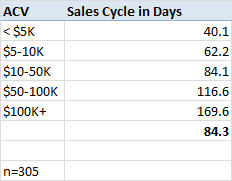
SaaStr founder Jason Lemkin has offered a similar benchmark for B2B SaaS sales cycles:
Given that more expensive products often require buy-in from multiple decision-makers at a company, significant budget planning, and a series of product demos or meetings to demonstrate the product’s value, it’s no surprise that they have a longer sales cycle.
The more customization options available with your product, the more demos or support your leads will likely need before they decide to buy. As stated earlier, customization options for SaaS products naturally create back-and-forth negotiation periods that can eat up a lot of time.
If you offer a free trial of your product, the length of the trial will naturally add time to your sales cycle, as customers will typically not purchase before the free period is over. That’s not to say you shouldn’t offer trials, but be mindful of their length, factor it in when calculating your sales cycle length, and make sure your reps are checking in with prospects during their trial, not just when it’s over.
Short free trial periods accomplish two things: They shorten your sales cycle and they incentivize users to act quickly. Users who start a trial with a 7-day or 14-day limit are more likely to test out the software immediately, while users who start a 30-day trial might get complacent and put off testing it until the trial is over.
“Our average deal is open for 21 days, with our free trial being 14 days long,” explains Mike Carroll, Head of Growth at Nutshell. “Organizational urgency and project focus on the client-side are the largest contributing factors to the length of our sales cycle.
“While our prospects are in our cycle for 21 days, they’ve usually been engaging our brand for at least two months prior. Our ability to quickly identify and satisfy needs, pain points, and technical requirements directly affect the length of our sales cycle.”
You can’t expect to transition to SaaS sales from a non-SaaS selling role and immediately find success. There are a few fundamental aspects of SaaS sales that take a lot of getting used to, and even veteran SaaS sellers find it to be a difficult path at times.
We asked a few SaaS sales experts what they think is the most difficult element of selling software as a service. Listen up:
“The biggest challenge is that there’s always going to be a ton of competitors popping up in your space, so you really need to understand how you differ from each competitor,” says Dustin Crawford, Sales Manager of Inbound & Outbound at Intercom. “Once you know where you’re stronger and where you have areas for improvement, then you can figure out how you can actually win against them.
“You also need to understand all the different technologies your customers use, because when you’re selling a SaaS product, your customers will be integrating it with a ton of other solutions.”
Which technologies does your solution play nice with and how do your competitors’ integrations stack up? If you know you don’t offer a certain integration that’s extremely important to the prospect, then you shouldn’t be spending your time there because you’re going to lose.”
Dustin Crawford, Sales Manager of Inbound & Outbound at Intercom
“I think [SaaS salespeople] get so caught up in, ‘My product is the best, my product is the best, why do I keep losing?’ You have to understand that the people on the other end have to integrate your solution with their software stack, and they have to deal with their engineers or their IT team in order to implement your solution.”
Heavy competition isn’t just a challenge when a buyer is first evaluating solutions. Once you have a customer, you have to be constantly vigilant that another company doesn’t swoop in and eat your lunch.
“I transitioned from client server sales to SaaS, and the biggest change is that it’s much easier for customers to switch from you to your competitor,” says Jane Van Sickle, Sr. Director of Sales & Onboarding at Unbounce. “It’s critical that your sales team sells a solution that will meet the customer’s needs and that you help your customers onboard with your product, because if they don’t adopt it and see success they’ll find another solution.”
While SaaS selling requires a lot of upfront education, there’s also a danger of overexplaining. “What ends up happening is you can overload a customer with too many ‘bowling balls’ and some are bound to be dropped,” says Kyle Ferretti. “Getting my reps to streamline and only discuss the most important tools pertinent to the customer is a big challenge.”
The other reason that over-focusing on product features can be a pitfall in SaaS sales is because any unique feature your product has will soon be copied by a dozen other solutions. “Weekly product releases means vendors are leapfrogging each other constantly,” says Mary Mitchell, Conversational Marketing Advisor at Drift. “You need to explain why you do ‘it’ better and not just simply convey a list of features that may be at parity from one moment to the next.”
Noise level is at an all-time high, and breaking through the clutter to capture the attention of prospective buyers has never been more challenging.
Mary Mitchell, Conversational Marketing Advisor at Drift
Last but not least, the frantic pace of the software industry creates constant distractions for SaaS salespeople. “I think the biggest challenge today in SaaS sales is a lack of focus,” says Evan Cassidy, Team Lead, Enterprise Sales at Drift. “Startups are moving incredibly quickly and there’s high expectations both internally and externally for modern sellers to deliver value quickly. Being able to focus on the highest impact item on a daily basis is becoming a superpower.”
“I collect data like baseball cards,” says Dustin Crawford. “I think it’s important to have as much data as you possibly can because data tells you stories.”
There are dozens of different metrics for analyzing SaaS sales, but the ones below are perhaps the most important for your bottom line.
Monthly recurring revenue or MRR is the amount of revenue your company expects to bring in every month, based on the value of your current customers’ subscriptions.
MRR keeps the lights on, which is why you should always have an idea of how much you’re bringing in. Luckily, MRR is fairly simple to calculate. Simply add up the monthly fee paid by every customer.
Annual recurring revenue or ARR is a measure of how much revenue your company would bring in over the course of a year based on your current subscription value. Essentially, it’s MRR multiplied by 12.
We look at new MRR, number of new customers, number of customers still with us at 90 days as well as their MRR…We also look at a number of feature-usage metrics during the first 90 days that indicate customer adoption.”
Jane Van Sickle, Sr. Director of Sales & Onboarding at Unbounce.
The customer acquisition cost (CAC) is the average cost of signing a new user. Your advertising budget and the efforts of your sales and marketing teams all impact your CAC.
To calculate your CAC, simply divide the total cost of your sales and marketing expenses by the number of customers acquired in the same period.
Customer lifetime value (LTV) is the amount of revenue an average customer will generate over the course of your relationship with them. As long as your LTV generously outweighs your CAC, you have the makings of a successful business, which is why it’s important to know both.
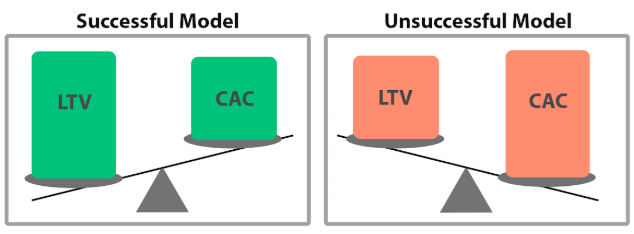
To calculate the LTV, multiply the customer value (the average purchase value multiplied by the average purchase frequency rate) by the average customer lifespan.
While this might sound relatively straightforward, you do need to calculate a few averages first before you can land on the CLV. This guide breaks it down into five simple steps that anyone can tackle.
Nobody wants to see customers go, but it happens. Your churn rate is the percentage of customers leaving every month or year, which you can then compare against industry benchmarks to gauge the overall health of your company.
To find the churn rate, divide the number of customers who leave during a given period by the total number of customers during the same period, then multiply by 100 to get the percentage.
Related: How to calculate customer churn rate (+ the best SaaS churn formula)
If you’re really lucky, your business can achieve negative churn, in which the additional revenue from existing customers expanding their subscriptions consistently exceeds the lost revenue from customers canceling their subscriptions.
SaaS salespeople use a wide variety of online and offline communication methods to nurture prospects, so it’s important to gather data on which activities are having the most success.
“Like any team, I’m always looking at calls, emails, all that fun stuff,” says Kyle Ferretti, “but as time goes by, demonstrations of our product tend to be a lead indicator of a successful rep on my team. It gives them the biggest opportunity to help a customer through the tool and make sure they end up on a plan of ours that fits them the most.”
“At Drift we’ve established a set of ‘north star’ metrics that keep us focused on high value activities,” says Mary Mitchell. “For example, when you know how many meetings and demos it takes to produce closed/won revenue, you can work with your BDR to set outreach goals for the number of touches it takes to produce those meetings.”
The win rate shows you how your sales teams or reps are stacking up. It’s simply the percentage of your total leads that are closed by your sales team over a specific timeframe. There are a couple of ways you can find those numbers for the formula, so read this if you want to dig in further.
Once you know the win rate, you can figure out how many leads need to be in your pipeline at a time to meet your goals. You can also identify which sales reps could use more coaching and training so they can increase their win rate and meet their quotas.
As a manager, I want to understand how my reps win and how we can grow. So I look at everything from activity levels to the individual reps that each lead is going to, because maybe a rep isn’t having a high success rate with the type of meetings they’re getting.”
Dustin Crawford, Sales Manager of Inbound & Outbound at Intercom
Deal velocity is the average length of time it takes for a lead to move through your pipeline. “The metric I focus on personally is deal velocity, because it ensures I am bringing in deals on a consistent basis and moving on to the next,” says Evan Cassidy. “Larger deals can take a lot of effort so I want to make sure I am not spending too much time just on one deal, but rather moving them every day and every week where possible.”
While looking at activity levels and individual win rates of your sales reps helps you optimize your process, it’s also important to study customer and market attributes, such as which industries have the most need for your product, where you do well geographically, your prospects’ company sizes, and whether or not they’re public or private. (Public companies generally take much longer to move through the deal cycle because there’s a lot more red tape internally.)
“I used to manage the outbound team at Base CRM, and CRM is a hard ballgame to play because we were rolling up against Salesforce,” says Dustin Crawford of Intercom. “How do you go up against a beast like that? For me, it was a matter of looking at these little attributes to understand where we were going to find success.
“I always looked at the employee size of our target companies, but what I specifically wanted to know was the sales team size compared to their entire employee size. If their sales team was about 20% of their total employee count, that told me that they’re a sales-oriented company and they’d be willing to spend money on a sales tool if I could show them that what they were doing today is inefficient.
“Instead of going straight ahead against our largest competitor, I went looking for big companies in an enterprise space that were on legacy systems with weaker technology than us. A lot of companies on the East and West Coast are ingrained in Salesforce because they’re tech-savvy, but in the Midwest, there were a ton of big companies that weren’t, and that was something that we’d grasp onto in order to build up momentum.”
You know what to expect of your sales cycle, you’ve got a list of metrics to focus on, and you know the pitfalls to avoid. These SaaS sales techniques will help you bring it all together.
SaaS customers want to know not just how your product works, but specifically how it will work for them. “As a team that focuses heavily on consultative selling, our highest converting sales tactic is the custom and/or live setup call, where a CRM expert from our team helps potential customers configure their CRM to match and achieve their objectives,” says Nutshell’s Mike Carroll. “When you have a product with as many ‘nooks and crannies’ as we do, personalized support and education are critical.”
A “1-to-many” demo is a semi-personalized webinar hosted by a SaaS sales rep in which a small group of interested prospects can attend a live overview of your product, then have an opportunity to ask the host individual questions.
“Between the free trial and the 1:many demo, SaaS customers can engage with and use your product without ever engaging a sales professional,” Carroll says. “Most other service and B2B product-related companies don’t offer an option to create a completely self-service purchasing experience, but SaaS companies like ours have a pretty focused ‘DIY’ type of model where users can engage and leverage the software, or should be able to, with little help from your team. ”
When a user signs up for a trial, you should subscribe them to an automated email sequence that provides resources, demo videos, or other forms of support so they can get the most out of their experience. This is also a good opportunity for a sales rep to reach out directly and offer one-on-one guidance, which can double as prospect qualification. (See the “Stages in a SaaS Sales Process” section for more on that.)
A documented and thorough follow-up system ensures your sales reps are never left guessing what step to take next and prevents possible customers from slipping through the cracks.
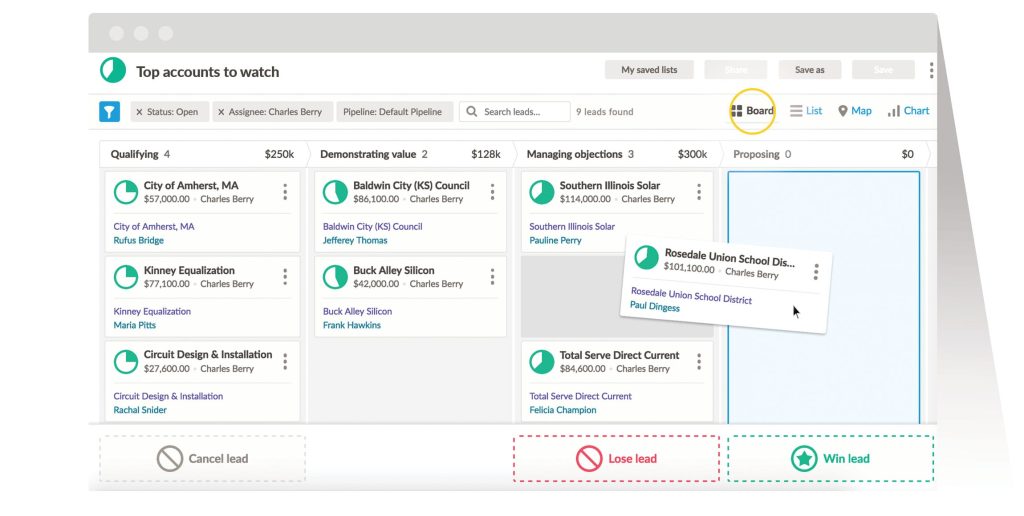
A customer relationship management (CRM) platform with sales automation features not only makes your process easy to follow even for new sales reps, but it can even automate follow-up email sequences so that your reps never drop the ball.
Many SaaS products offer a slight discount in exchange for the customer paying the year’s entire bill at once, as opposed to paying monthly. Customers feel like they’re getting a deal, while the company gets a sizable influx of cash and doesn’t have to worry about the customer churning at any moment.
Quick story: When Nutshell raised prices on our legacy “Classic” subscription in 2018, we offered our customers one more year on their old price if they upgraded from monthly plans to annual plans.
This strategy was a win-win, as our customers got to postpone the price increase for a full year, while we were able to reduce churn and bank a significant amount of revenue from customers taking us up on the deal.
Upselling and cross-selling are strategies you can apply both during the initial sales process and throughout your relationship with a customer.
Upselling refers to encouraging the purchase of a more expensive version of a product, while cross-selling refers to additional products.
As a salesperson, these techniques help you win bigger deals. For your customers, it helps them get more value from your SaaS products.
Upselling and cross-selling require listening carefully to your customers’ needs and identifying solutions that could help them get more from your SaaS products.
Looking for even more sales tactics? Check out this comprehensive guide to 19 strategies you can swear by.
“Having a repeatable process empowers your sales reps to sell with confidence and efficiency, and as a leader it allows you to coach more effectively,” says Jane Van Sickle. “For your reps, it takes an experience that can be very complex and makes it understandable.”
A typical sales process can be broken down into the following pipeline stages:

While you could certainly use those same stages in a SaaS context, there are some important differences when it comes to what those stages entail and the tasks they include.
Since you’re selling to a tech-savvy audience that is constantly searching for information online, inbound marketing is a very effective way to capture SaaS leads. There are several ways to get on your ideal client’s radar, including:
Another way to find SaaS prospects is at trade shows and conferences. These events give you an opportunity for face-to-face contact with potential buyers—a rare opportunity in the SaaS industry, where nearly all prospect communication is done remotely by email, phone, and video-conferencing.
For further reading:
Product qualified leads: Why trial users are so valuable in B2B sales
The 16 best sales prospecting tools that integrate with your CRM
How to create sales enablement content that does the selling for you
Not all visitors to your blog or trial subscribers are worth pursuing. You need a method of qualifying leads so sales reps can follow-up with the best prospects.
Lead scoring is an automatic way to qualify leads. A platform like LeadBoxer gathers and interprets data about your website visitors, then assigns them a score from 0 to 100 indicating their likelihood of closing.
A more hands-on way to qualify leads is to have one of your sales development representatives call or email soon after they start a trial of your software. A quick five-minute phone call is often all it takes to determine if the prospect has the interest and need to be moved onto the next stage.
Having a dialed-in email sequence with plenty of follow-up opportunities can be the bread and butter of your SaaS sales process. The goal is to get qualified prospects into a one-on-one meeting where you can learn more about their pain points and demonstrate the value of your software.
But as we wrote before, face-to-face contact is a rare occurrence in SaaS sales, which means you have to rely on a different set of skills.
“When you’re face-to-face you can rely on body language as a selling tool, which is out the window on the phone,” says Kyle Ferretti of SEMRush. “So you learn to be more conscientious of a customer’s tone and interest via their voice instead, which isn’t always easy.”
Learn the email tactics that B2B sales pros use to hook their customers.
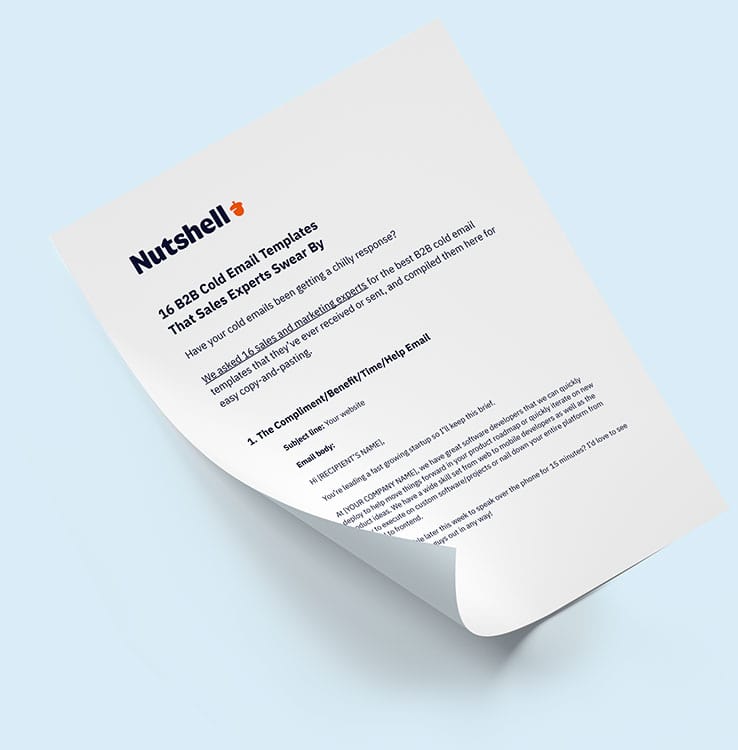
After presentations, prospects are likely to have questions or concerns that could potentially sink the deal if they’re not addressed gracefully. According to Steli Efti, CEO of Close, two of the most common objections in SaaS sales are “Your product is too expensive” and “Your product doesn’t have the right features,” and they both require you to do a better job demonstrating your product’s value:
“What the pricing objection really means is that you haven’t properly communicated your product’s value. You need to work together with the prospect to understand who will be using your product and what benefits they’ll get: increased productivity, better margins, more customers—whatever that value is, make it clear to the prospect that it outweighs the price…
“When they ask about a missing feature, it means that in their mind, there’s a gap between what your product can do and what they need it to do—some burning issue they don’t think it can solve…You need to dig beneath the surface by asking questions that uncover the real, pressing need behind this feature. That’s the best way to refocus the conversation on your product’s value.”
This is the moment when the prospect becomes a customer. In this stage, you’ll deliver the final proposal, make any negotiations, and have everyone sign on the dotted line.
One tip we can share from experience: Don’t rely on discounts to close stubborn prospects. Stunning’s guide to closing SaaS sales sums up the problem very well:
While they may help persuade a customer to choose you over your competition, discounts will eventually eat away at your profits and set you up for failure. The type of customer who demands discounts are usually the hardest to deal with. That’s because those who are obsessed with price are also the loudest complainers. But, if you slash your prices to close a sale with this type of customer, you’ll have to sacrifice quality.”
“Not only will a customer who is only worried about price leave you when a cheaper competitor comes along, but they’ll also expect a discount when it’s time to renew. It’s a no-win scenario. If you offer a flat 25% discount off of a recurring monthly subscription, you’ll feel that discount every month.
A better solution to offering a discount is to give away a free month in exchange for annual prepayment.”
Retaining customers is vital for a SaaS company. In addition to offering excellent customer support for all their post-sale needs, consider:
Which software tools do SaaS sales professionals rely on to sell their own product? Every team’s SaaS sales stack is different, but a few basic elements are absolutely necessary.
“The most important thing is your CRM, and you have to pick one that will integrate and play nicely with all your other software,” says Dustin Crawford. “You also need a lead gen tool like DiscoverOrg or Zoominfo, which saves you a lot of time finding prospect data and getting it into your CRM. You have to be really efficient with that process, because it can take hours out of your day otherwise. The same goes for your email automation tool—having something that integrates seamlessly with your CRM is critical, because email is where we spend a lot of our time.
“And obviously I’m biased here, but live chat is extremely beneficial for an organization. People are communicating way differently than they did even three to four years ago. Buyers don’t come onto a website and stay there until they find every bit of information they need. They’re window shoppers. They’re going to browse your site, and if they don’t find what they’re looking for immediately, they’re going to go see if your competitor has it. Without live chat on your website, you might be losing a lot of people who are genuinely interested. So that’s a very inexpensive way to attract new prospects and customers that you probably weren’t even aware of.”
In addition to your CRM, prospecting tools, email automation (both marketing automation and personal email sequences), and live chat, we recommend the following tools to complete your selling arsenal:
Having a predictable sales cycle, effective sales techniques, and the right tools are all invaluable for reaching your SaaS sales goals. It takes time to get all these variables up and running, and even more time to fine-tune your process so that leads flow quickly through your pipeline and good prospects aren’t getting lost.
The best tool you have at your disposal? A simple and effective CRM. A CRM automates your sales process, manages your pipeline, effortlessly tracks the metrics that are important to you, and unites all your essential selling tools in one place. That means less time spent composing routine emails or doing data entry on spreadsheets and more time spent delivering an exceptional experience to your prospects.
There are countless CRM platforms out there, but if you’re looking for an option that’s easy to use right out of the box, then give Nutshell a try.
No problem. To see if Nutshell is the right choice for your sales team, start a 14-day free trial today!
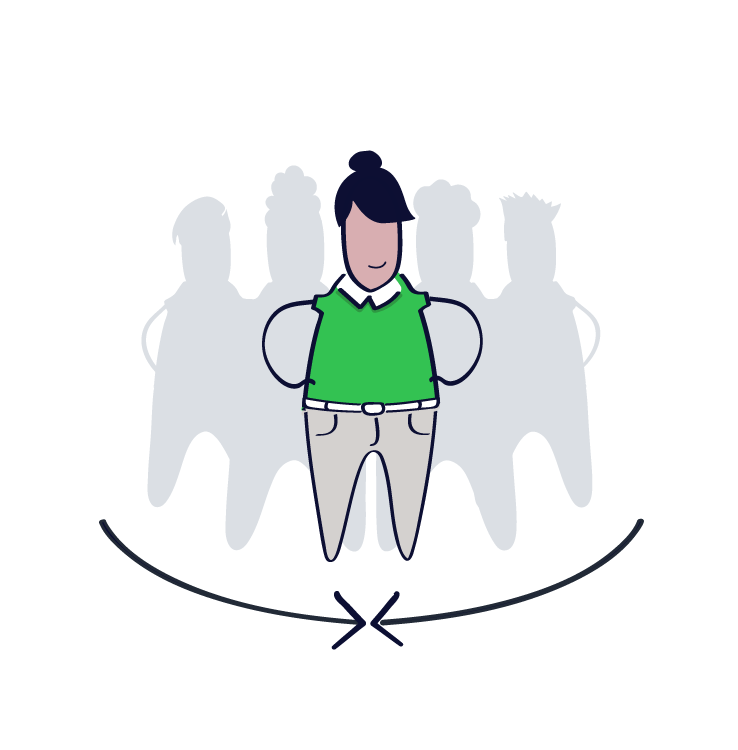

Join 30,000+ other sales and marketing professionals. Subscribe to our Sell to Win newsletter!